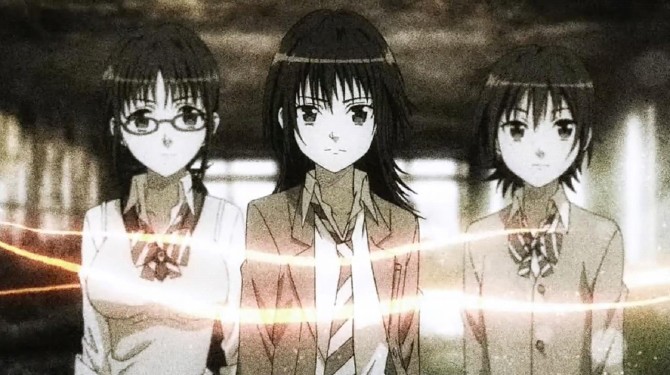Where Are You “Going”?
October 5th, 2014 in Anime, Chronicles of the Going Home Club, General Reviews by The Droid

“Chronicles of the Going Home Club” is another in a long series on ‘nothing’ shows, although they eventually decide to do ‘something’. Closer aligned with “Joshiraku” and “Nichijou”, it tells the stories of five girls who just want to have a good time.
For those unfamiliar with the term, the “Going Home Club” refers to students who do not belong to any club, ending up going home to study or read anime or take a trip to Akihabara. But for this series, the Going Home Club is an actual club. Sure, they may play video games or eat snacks, but they eventually talk about stuff, things that have a bearing on their lives. So the first three or four episodes are spent setting up things, so nothing happens and what they talk and do is disconnected. So there is no real direction. But someone decides they need to have some degree of focus and that’s when the show really takes off.
Our Slacker Sisters are (left to right):
Sakura Domyoji, president of the club and the ‘ordinary’ one.
Karin Tono, supervisor and a tad of an airhead (more…)
Tags: School, Seinen
In the “Works”
August 26th, 2014 in Anime, General Reviews, In the “Works” by The Droid

Part of the problem with magic shows is that everything is eventually going to link back to ‘Harry Potter’, and “Witch Craft Works” does have some touch-and-go moments to Harry, but it can’t fully commit to what it wants to be.
Takamiya Honoka is a regular student at Tōgetsu High School. He is a standard, typical anime male, in the fact that not only is he clueless, he pines on endlessly for the Most Popular Girl in the School. He also lacks the spunk or the desire or the lead in his pencil to speak with her. The person in question is Kagari Ayaka, the school’s “Princess”. She is everything you want your girlfriend to be: she’s pretty, she’s smart, she’s adored, she’s tall and (although you can’t see it in this shot), build like a brick chicken house. They have never spoken to each other and any small interaction between them immediately results in her fan club beating him for his insolence.
One day he is attacked by a quintet of oddly-dressed girls called the Tower Witches, who had been covertly making attempts on him. However, the attack is thwarted by Ayaka, who turns out to be a Workshop Witch and has been protecting Honoka for quite some time. No longer having to hide her mission, Ayaka decides to become friendlier with him, though their relationship earns Honoka the ire of a lot of his class mates. She also decides that he needs to become her apprentice so he can at least learn how to defend himself from these almost daily assaults. (more…)
Tags: Action, Fantasy, Magic, Seinen, Supernatural
Fair “Weather” Friend
August 3rd, 2014 in Anime, General Reviews, Non Non Biyori by The Droid

This is certainly a stunning example of a ‘nothing’ show. OK, things do happen, but they are not of great or grand designs, as least not in our lives. But such is “Non Non Biyori”. The title is a bit confusing, as it means “Non non weather”, but then that means we are mixing language (‘non’ is French for either ‘no’ or ‘not’, so I read this as Not not weather? Should there be a hyphen? But I digress).
Greetings and welcome to the countryside village of Asahigaoka. Being where it is, like, not even on the map, many conveniences are several miles away and the school consists of only five students, each of whom come from different grades of elementary and middle school.
Hotaru Ichijo, a fifth year elementary student from Tokyo (the tall number on the far right), transfers into the Asahigaoka Branch School and adjusts to countryside life with her new friends. Taking role call: (more…)
Tags: Comedy, School, Seinen, Slice of Life
Crazy Like a “Fox”
June 30th, 2014 in Anime, General Reviews, Gingitsune by The Droid

What is it like to be a real temple maiden? What it is like to really be able to see the holy messengers? What is it like to be different? What is it like to not open a review with a series of questions?
“Gingitsune” tells the tale of Makoto Saeki (the one with the broom). She is a temple maiden and can see these heralds from the gods on high. Dad Tatsuo (carefree schlub at the far right) does not have this ability, so he has to rely on Saeki to help him out. There used to be two heralds at the temple (and there seems to be a rule that there are to be two), but Gingitsume (or ‘Gin’, as he is known, that really, REALLY big fox herald) is all there is. His partner left (or died or was recalled or went sightseeing) and he spends his days sleeping and eating tangerines.
He is a grumpy number, but if you had been around for 800 years or something like that, you’d be cranky as well. And I can’t imagine how his underwear rides up on him. That would make me very cross, especially if it was that way through the whole Meiji restoration! (more…)
Tags: Seinen, Slice of Life, Supernatural
Silence is “Golden”
June 28th, 2014 in Anime, General Reviews, Golden TIme by The Droid

For those in the medical profession, Golden Time, (or the Golden Hour), refers to a time period lasting for one hour following traumatic injury being sustained by a casualty or a severe medical emergency, during which there is the highest likelihood that prompt medical treatment will prevent death and/or minimize damage. Our anime series, “Golden Time”, follows the aftermath of such an event, although the title can have a double meaning
We start off with Banri Tada. While in his last year of high school, he suffered a traumatic head injury in a traffic accident that flung him off a bridge, that nearly killed him in the process, that effectively erased his memory and personality, so he recalls nothing of the event, save that it did happen.
He transfers to a new college to start a new life, but it is already fraught with peril. Late on the first day, he runs into Mitsuo Yanagisawa, and they immediately hit it off. As they get to school, a gorgeous blonde presents Mitsuo with a bouquet of roses….which she proceeds to smack him with. This is Koko Kaga and she and Mitsuo have been childhood friends since childhood and she is to marry him. But Mitsuo fled his hometown to start a new life here….without Koko. Not going to happen, dude. (more…)
Tags: Comedy, Romance, Seinen
Year End Review – “Space Brothers” Year Two
May 11th, 2014 in Anime, General Reviews, Year End Reviews by The Droid

Again, another long-format show, this one has managed to keep the interest high, as there is just so much that goes on behind the scenes that we do not know of.
Now, they are calling it Season Four, as each ‘season’ is 25 episodes, but I call it Year Two, as we are at 100 episodes.
The year opens up with two flashback/recap episodes, one for Mutta and one for Hibito and then we proceed. The two massive arcs are Hibito’s Panic Attacks (which take up right to the end of the year) and how Mutta overcomes all the obstacles placed before him in order to discourage him from being an astronaut. The stories were told with a great deal of involvement and there was hardly an off-note for the year, although the Olga side-story for Hibito went on a bit long. (more…)
Tags: Comedy, Sci-Fi, Seinen, Slice of Life, Space
“Cop” a Plea
April 20th, 2014 in Anime, Coppelion, General Reviews by The Droid

This could broadly be described as another of those “Girls Who Save the World” shows, but it is handled in a slightly different fashion, in that there are no transformation sequences, but their goal is not much different than “Sailor Moon” or Symphonia”.
“Coppelion” tells the story of (left to right) Taeko Nomura, Ibara Naruse and Aoi Fukasaku, who are not what they appear to be. Are they high school girls, on a class trip to Kyoto so they can look at the temples and take advantage of the cuisine there? Not hardly likely.
In 2016, a ‘incident’ at the Odaiba energy plant contaminates all of Tokyo and everyone has to leave (and they never say that it was a nuclear meltdown, although all the Hazmat suits, Geiger counters and radiation symbols plastered everywhere are enough to make it so). But not everyone leaves, for whatever reason. Twenty years later, a distress call is heard from Old Capitol and these girls are dispatched to answer the call.
So these aren’t even real girls. They are clones who have been biologically engineered to be able to withstand massive levels of radiation that would turn the rest of us into instant goo. They are to render immediate first aid and then get those people out of there. The story details their efforts, but it is more than a “Who can we save this week” approach, as that would get boring really fast. (more…)
Tags: Action, Sci-Fi, Seinen
Nerves of “Steel”
April 6th, 2014 in Anime, Aoki Hagane no Arpeggio, General Reviews by The Droid

How many of you folks know what an ‘arpeggio’ is? Sure, most of you could identify it immediately as something related to music, but the real definition is a musical technique where notes in a chord are played or sung in sequence, one after the other, rather than ringing out simultaneously. This word comes from the Italian word “arpeggiare”, which means “to play on a harp.” An alternative translation of this term is “broken chord.”
Arpeggios allow monophonic instruments to play chords and harmony and help create rhythmic interest. The title is most supportive of “Arpeggio of Blue Steel (“Aoki Hagane no Arupejio”), which looks like a mere submarine anime, but it’s more than that.
In the year 2039, it’s a mess. Humanity, via global warming, has reduced a lot of their land mass. In that year, a strange alien force came down. Known as the Fog, they manifest themselves as naval vessels and successfully blockaded the oceans, so humanity was cut off from one another. 17 years after the blockade (that’s now 2056, if you are trying to do quick math), Gunzō Chihaya, a former student of the Japanese National Marine Academy, is captaining a Fog submarine that defected and joined humanity’s plight. Technically referred to as I-401, Iona is the Mental Model for the Blue Steel submarine. Chihaya and crew are pirates or renegades, or, more to the point, blockade runners. They can deal some major hurt to the Fog fleet. (more…)
Tags: Action, Sci-Fi, Seinen
Short Run Series XI: When I Was a “Lad”
March 17th, 2014 in Anime, Blood Lad, General Reviews, Short Run Series by The Droid

Being a demon is tough and when you are a territory boss in the East Demon World, it’s even tougher. In “Blood Lad”, Staz Charlie Blood is the descendant of a noble vampire, and his father would go to the human world to suck blood. Not Staz. If he went to the human world, it’s off to Akihabara for the latest in video games, animes and figures. However, one day, he meets Fuyumi Yanagi, a regular old-fashioned girl who wandered into Demon World through a portal that opened in her bedroom.
His staff wants to suck her blood; he wants to impress her with his ‘knowledge’ of human things (thus the bizarre get-up he has on). Sadly, this little tryst is broken up when a neighboring demon boss is set on taking Staz’ territory and unleashes some hideous beasts. Staz manages to defeat all of them….but one, who manages to get to his apartment and devour Yanagi, turning her into a ghost. Since this is the first girl Staz has ever met and seen really close up, he vows to do whatever it takes to make her human once again. (more…)
Tags: Comedy, Demons, Seinen, Supernatural, Vampire
On The “Edge”
November 26th, 2013 in Anime, General Reviews by The Droid

Another horror offering, this one approaches it with a different angle. Is there blood? Not as much as you may think, but there is still a large caliber of terror and destruction.
The proper title for this show is “Dansai Bunri no Crime Edge” or “The Severing Crime Edge”. Let’s talk about Kiri Haimura. If there is anything he loves most in the entire world, it’s cutting hair. He will cut anyone’s hair and he does a fabulous, fabulous job with it. He then sees this girl, Iwai Mushanokoji. She has hair down to the ground, because it is cursed. It cannot be cut by any means (chain saw, blow torch, laser beam). Yet, somehow, Kiri can do it with his simple scissors. But we learn these are no ordinary scissors.
These are “Killing Goods”. People in and of themselves are not killers, but when they come across the implement that will allow them to become killers, they are possessed by their tool of choice. That pair of scissors (and why is it a ‘pair of scissor’ when there is just the one? Is it odd to call it scissor?) belonged to an ancestor of his, Norma Grayland, who owned this pair of scissors which could cut flesh and bone and he purportedly killed over 200 lost souls in the 1860s. (more…)
Tags: Action, Fantasy, Romance, Seinen









